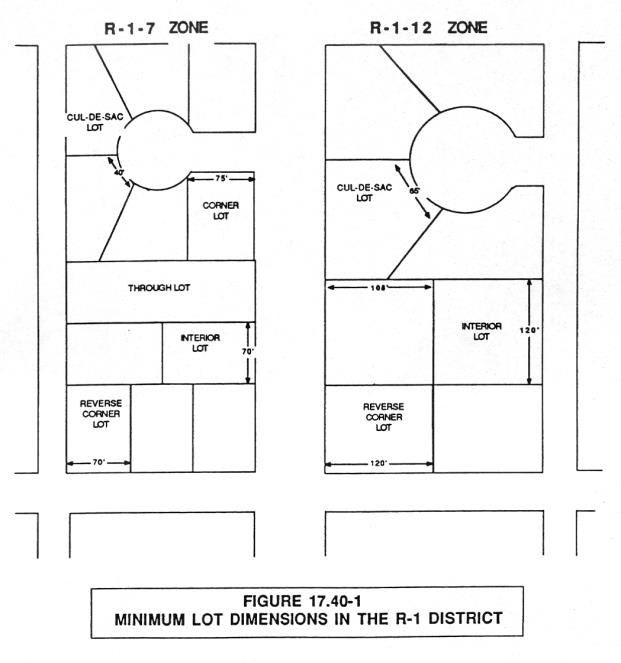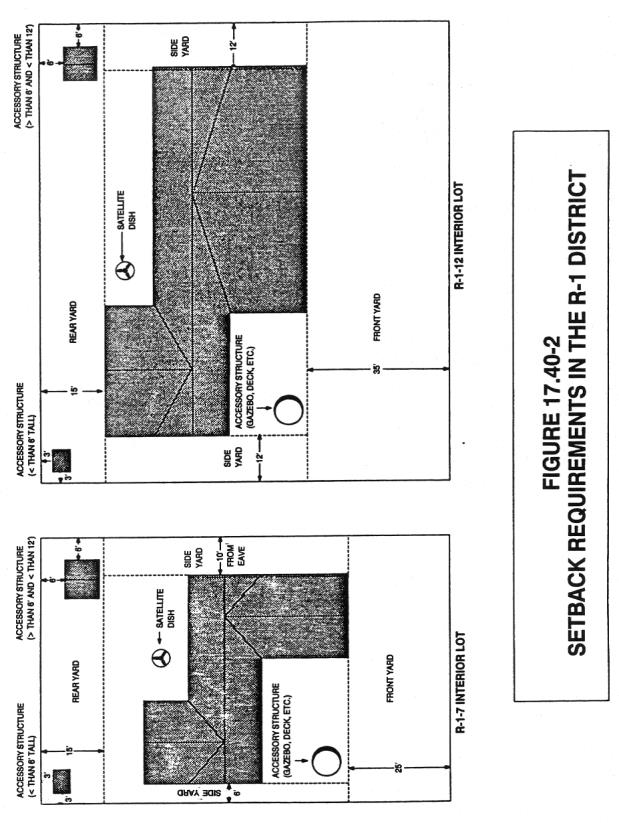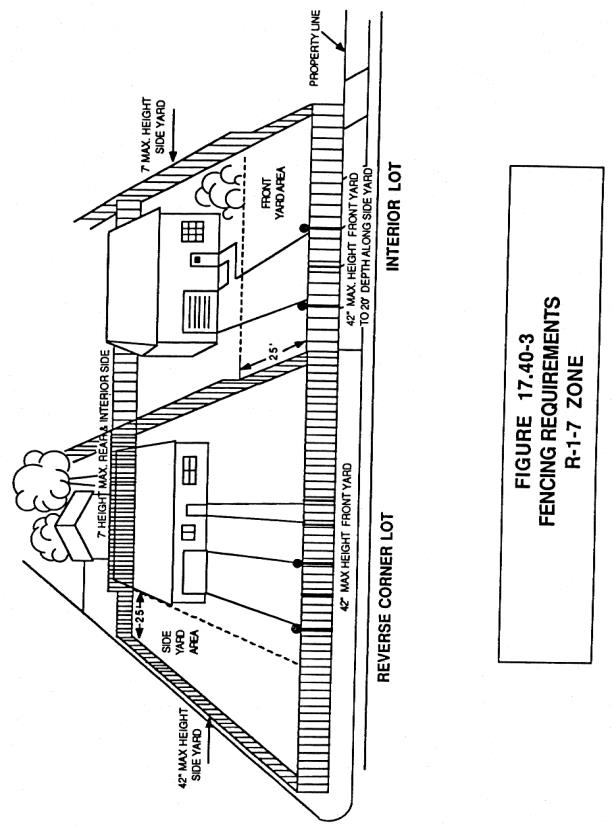Chapter 17.40
R-1 SINGLE-FAMILY RESIDENTIAL DISTRICT
Sections:
17.40.040 Development standards.
17.40.050 Accessory structures.
17.40.070 Fences, walls and hedges.
17.40.090 Architectural standards.
17.40.010 Purpose.
The purpose of this district is to provide for residential areas within Kerman which allow a range of densities for single-family homes, and uses compatible with the single-family district. This district shall promote an environment which is free of traffic and parking congestion, significant noise levels, and uses which are not complementary to residential neighborhoods.
This district provides for two single-family residential zones: R-1-7, and R-1-12. The purpose and intent of each zone is based on the policies and objectives outlined in the Kerman general plan. The R-1-7 zone shall be reserved for traditional types of single-family development. The R-1-12 zone is intended to create a boulevard effect along certain streets in Kerman. This district is generally reserved for streets which serve as major entryways to the community. (Ord. 90-02 §2(part), 1990).
17.40.020 Permitted uses.
A. One single-family dwelling and accessory structures or one single-family manufactured home and accessory structures;
B. Licensed small family day-care home (eight or fewer children, as regulated by state law);
C. Temporary subdivision sales offices, model homes, and construction materials storage yards within a tract being developed;
D. Home occupations consistent with the requirements of Chapter 17.18;
E. Private greenhouses and horticultural collections, flower and vegetable gardens;
F. Recreational vehicle, motor home, travel trailer, truck camper, camping trailer, boat or boat trailer storage, consistent with the requirements of Chapter 17.78;
G. Cottage food operations (as regulated by state law);
H. An accessory dwelling unit consistent with the requirements of Chapter 17.66;
I. Employee housing;
J. Farmworker housing. (Ord. 19-01 §4, 2019: Ord. 17-03 §1, 2017: Ord. 16-03 §1(part), 2016; Ord. 09-04 §2(d), 2009; Ord. 90-02 §2(part), 1990).
17.40.030 Conditional uses.
Conditional uses in this district are as follows:
A. Private institutional uses, including but not limited to churches, cemeteries, hospitals, convalescent homes and charitable organizations;
B. Mobile home parks consistent with the requirements of Chapter 17.68;
C. Licensed large family day care home (eight to fourteen children, as regulated by state law);
D. Community care facility (six or fewer persons);
E. Public uses of an administrative, public service or cultural type including special district, city, county, state or federal facilities;
F. Utility and communication facilities, electrical distribution substations, and water pump stations;
G. Public educational institutions and schools;
H. Nursery school;
I. An accessory dwelling unit consistent with the requirements of Chapter 17.66;
J. Guest house. (Ord. 17-03 §2, 2017: Ord. 09-04 §2(e), 2009; Ord. 90-02 §2(part), 1990).
17.40.040 Development standards.
The following development standards, together with applicable standards specified in Chapter 17.78, shall apply to all land and structures within this district.
A. Minimum Lot Size. The minimum lot size for each residential zone shall be as follows:
|
Zone |
Lot Size |
|
R-1-7 |
Seven thousand square feet. |
|
R-1-12 |
Twelve thousand square feet. |
B. Coverage. The building coverage for each lot shall not exceed forty percent.
C. Lot Dimensions. The lot dimensions for each residential zone shall be as follows:
1. Lot Width.
|
Zone |
Lot Width |
|
R-1-7 |
Interior lot: Seventy feet. |
|
|
Corner lot: Seventy-five feet. |
|
|
Reverse corner lot: Seventy-five feet. |
|
|
Cul-de-sac lot: Forty feet. |
|
R-1-12 |
Interior lot: One hundred twenty feet. |
|
|
Corner lot: One hundred twenty feet. |
|
|
Reverse corner lot: One hundred twenty feet. |
|
|
Cul-de-sac lot: Sixty-five feet. |
2. Lot Depth. All lots in the R-1-12 district shall have a minimum lot depth of one hundred feet.
D. Building Height.
1. The maximum height of a main building or structure shall be thirty-five feet.
2. No accessory building or structure shall exceed twelve feet; except for garages and carports, which shall not exceed fifteen feet.
E. Yards.
1. Front Yard.
a. Cul-de-sac and curved lots within the R-1-7 district shall have a front yard setback distance of fifteen feet; however, the driveway shall be a minimum of twenty feet free and clear from the back edge of the sidewalk. A curved lot is a lot that has frontage of fifty percent or more along a curved street with a curve radius of one hundred feet or less.
b. The front yard distances for main structures in the following residential districts shall be:
|
Zone |
Front Yard |
|
R-1-7 |
Twenty-five feet. |
|
R-1-12 |
Thirty-five feet. |
2. Side Yard. The side yard distances for main structures in the following residential districts shall be:
|
Zone |
Side Yard |
|
R-1-7 |
Interior lot with alley access: Five feet. |
|
|
Interior lot without alley access: |
|
|
Five feet (See Section 17.40.040(E)(4) for exemption.) |
|
|
Corner lot, interior side: Five feet. |
|
|
Corner lot, street side: Ten feet. |
|
|
Reverse corner lot, street side: Fifteen feet. |
|
R-1-12 |
Interior lot: Twelve feet. |
|
|
Corner lot, interior side: Twelve feet. |
|
|
Corner lot, street side: Twelve feet. |
|
|
Reverse corner lot, street side: Twenty feet. |
3. Rear Yard. The rear yard distances for main structures in the following residential districts shall be:
|
Zone |
Rear Yard |
|
R-1-7 |
Fifteen feet. |
|
R-1-12 |
Fifteen feet. |
4. All required yard shall extend the full width or depth of the lot and shall be open from the ground to the sky, with the following exceptions:
a. Belt courses, cornices, eaves, sills, fireplace chimneys and other similar architectural features may extend or project into a required side yard not more than seven inches for each one foot of the width of such required side yard, and may extend or project into a front or rear yard not more than thirty-six inches. This section shall not apply to the ten-foot side yard in the R-1-7 district.
b. Uncovered, unenclosed porches, platforms, or landing places which do not extend above the level of the first floor of the building may extend into any front yard a distance of not more than six feet; and such features may not extend into a court more than twenty percent of the width of the court and in no case more than six feet, and may extend into any side or rear yard not more than three feet.
c. Open, unenclosed stairways or balconies not covered by a roof or canopy may extend or project into a required front yard not more than thirty-six inches.
d. Covered patios will be allowed to encroach up to five feet from the rear property line if they meet the following:
i. The lot must meet the lot coverage requirement;
ii. Patio cannot be enclosed;
iii. Must maintain a minimum five-foot setback--clear to the sky;
iv. The patio roof cannot exceed ten feet in height with a maximum pitch of two to twelve (2:12);
v. The applicant must submit a site plan (drawn to scale) for the building permit in addition to the structural rendition.
e. On R-1-7 lots without alley access, the ten-foot side yard setback shall extend seventy feet from the front property line towards the rear. The remaining length of the lot shall retain a five-foot setback.
F. Space Between Buildings.
1. Ten feet shall be the minimum distance between buildings used for residential uses.
2. All other accessory buildings shall be located not less than six feet from any main building. (Ord. 01-08 1, 11/7/01; Ord. 97-04 §1, 1997; Ord. 92-13 §1, 1992; Ord. 92-12 §§1, 2, 1992; Ord. 91-11 §1, 1991; Ord. 91-12 §1, 1991; Ord. 90-02 §2(part), 1990).


17.40.050 Accessory structures.
Construction of accessory structures shall be consistent with the standards established in Chapter 17.62. (Ord. 90-02 §2(part), 1990).
17.40.060 Signs.
Sign standards shall be consistent with the requirements of Chapter 17.76. (Ord. 90-02 §2(part), 1990).
17.40.070 Fences, walls and hedges.
A. Fences, walls and hedges shall be consistent with the site distance provisions established in Section 17.78.070(B).
B. Fences, walls, and hedges shall not exceed seven feet in height in any rear or interior side yard.
C. Fences, walls and hedges shall not exceed forty-two inches in height in a front yard.
D. Fences, walls and hedges shall not exceed seven feet in height in any street-side, side yard on a corner lot or street-side, side yard on a reverse corner lot. Any fence in these yard areas may be constructed on the property line.
E. Swimming pools shall be entirely enclosed by a wall or fence at least five feet in height. The wall or fence shall be equipped with self-latching gates, the latching mechanism being located not less than four feet above the ground. The fence or wall must be installed and approved by the building inspector prior to the pool being filled with water.
F. Fences or structures exceeding seven feet in height, to enclose tennis courts or other game areas, located within the rear half of a lot shall be composed of wire mesh capable of admitting at least ninety percent of light as measured on a calibrated light meter. (Ord. 01-07 § 1, 2001; Ord. 90-02 §2(part), 1990).
17.40.080 Parking.
Off-street parking and loading shall be consistent with the requirements of Chapter 17.74. (Ord. 90-02 §2(part), 1990).
17.40.090 Architectural standards.
The following architectural standards shall apply to all one-family dwellings and one-family manufactured homes in the R-1 district.
A. The minimum width of a primary one-family dwelling or mobile home shall be twenty feet.
B. Mobile homes must be certified under the National Manufactured Home Construction and Safety Standards Act of 1974.
C. All residential units shall be attached to a permanent foundation, pursuant to the State Health and Safety Code, Section 18551.
D. Roofing material shall be composed of composition shingles, ceramic tile, or wood shakes and shingles.
E. Exterior siding material shall be composed of, or look like, wood, masonry, or plaster.
F. Siding shall extend to the ground, except when a solid concrete or masonry perimeter foundation or retaining wall is used, in which case, the material need only extend to the top of the foundation or wall.
G. The roof pitch shall not be less than three inches of vertical rise for every twelve inches of horizontal run. (Ord. 90-02 §2(part), 1990).



